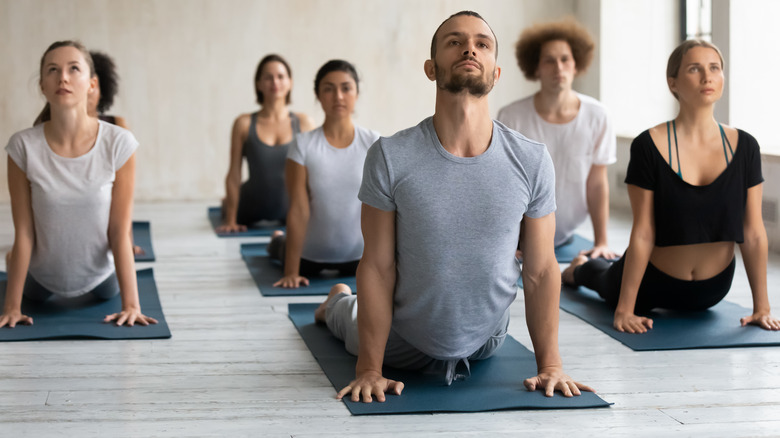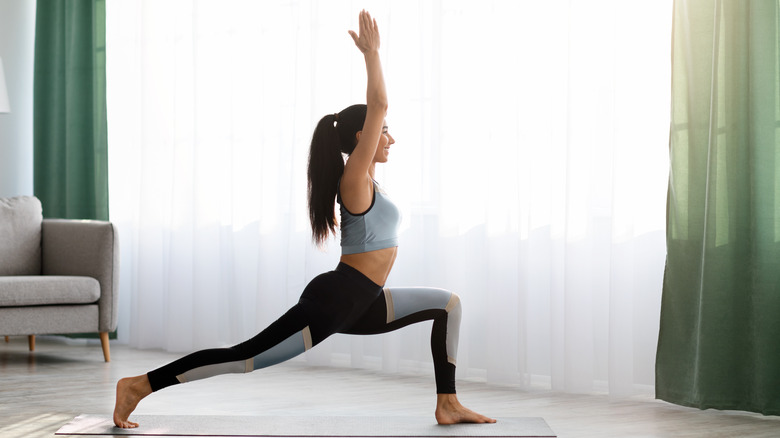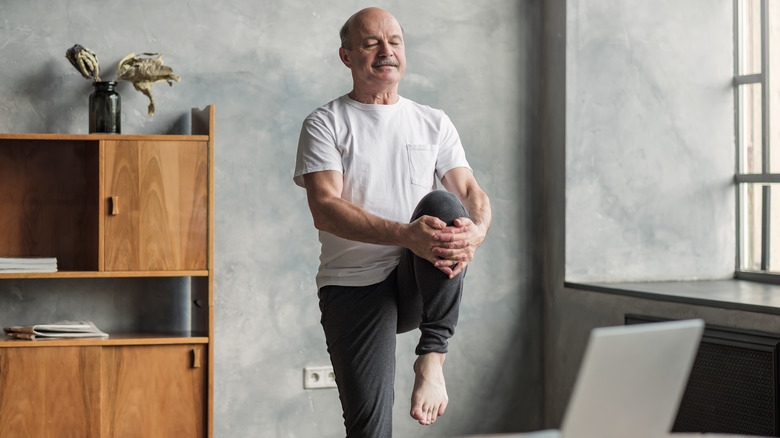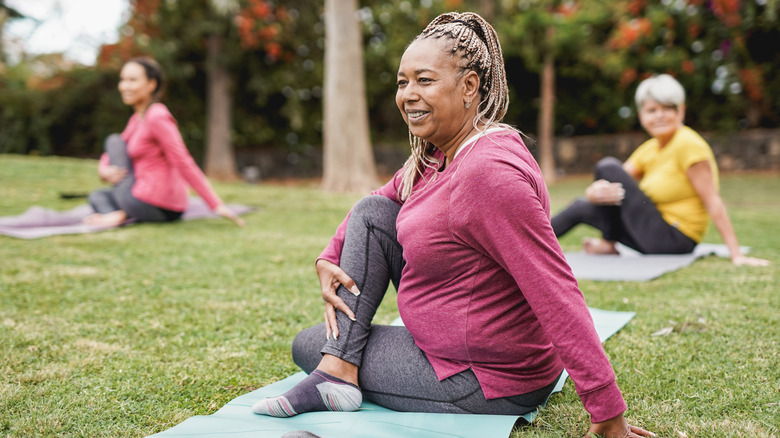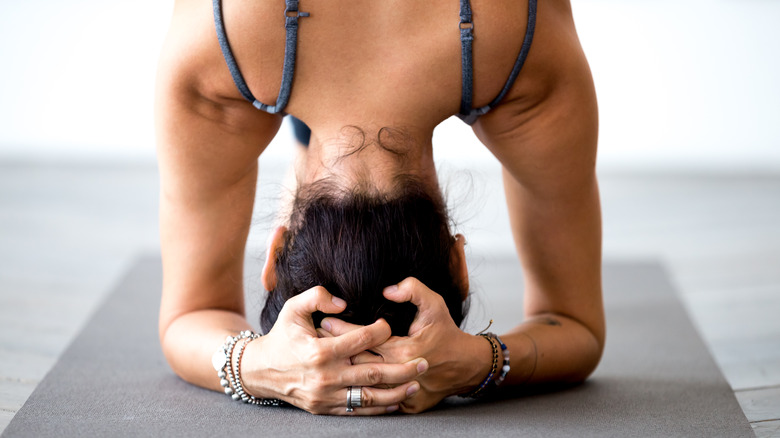Everything You Need To Know About Ashtanga Yoga
So you decide you want to try yoga. You get a class list online and see so many different offerings – hot yoga, yin yoga, Kundalini yoga, and Ashtanga yoga. Which do you choose? If you're looking for a yoga class to challenge your balance, strengthen your muscles, and improve your cardiovascular system, then you might like Ashtanga Yoga (per Harvard Health Publishing).
The word ashtanga refers to the eight-limbed union (via Learn Sanskrit). These eight limbs form the foundation of yoga outlined in the Yoga Sutras of Patanjali. Per Yoga Journal, these limbs are yamas (restraints), niyamas (observances), asana (the poses), pranayama (breath practices), pratyahara (withdrawal of the senses), dharana (concentration), dhyana (meditation), and samadhi (ecstasy). Only one limb of yoga, asana, pertains to the postures.
Pattabhi Jois established Ashtanga Yoga as a system of yoga postures, breathing exercises, and focus to attain clarity of mind (per Ashtanga Yoga). Even though allegations of misconduct surfaced after Jois' death (via The New Yorker), his style of yoga is still practiced all over the world.
The primary series in ashtanga yoga
Most Ashtanga Yoga classes focus on the primary series. Because Jois taught in Mysore, India, a Mysore class will have yoga students practice the primary series at their own pace with an instructor present to assist (per Yoga Practice). Therefore, a Mysore class might not be a wise choice if you're new to Ashtanga Yoga. Instead, opt for an Ashtanga Yoga class where all students practice together. This series is practiced the same way every time, so if you attend one Ashtanga class, the next will be familiar. Ashtanga yogis believe this helps with the mind-body connection because you're not wondering which pose is next (per Kerstin Pasterk Yoga).
After an opening chant, you'll warm the body with Sun Salutations, which use the breath to flow from one pose to the next. You'll begin to feel your body warm and your heart pump. Following Sun Salutations, you work on balancing and strength in standing poses such as Triangle, Side Angle, and Warrior. You'll get a good sweat here until you move to the seated postures such as forward folds, cobbler's pose, and boat pose. The finishing poses focus on inversions such as shoulder stand and headstand. You'll end the primary series like most yoga classes — resting flat on your back in savasana.
Ashtanga's breath practice
Although pranayama, the breath practice, is the fourth limb of yoga, there is no formal breath practice in Ashtanga's primary series. That doesn't mean breath isn't important. The primary series uses breath to move between the poses in the Sun Salutations. For example, you inhale while standing in mountain pose, then exhale into a standing forward fold. For the standing, seated, and finishing poses, the breath serves to count how long you hold the pose. Some poses might be held for five breaths, others for longer or shorter. The aim is to make the breath even, making each inhale and exhale long and smooth (per Ashtanga Yoga).
The breath technique used in Ashtanga is called ujjayi, which is sometimes called "ocean's breath" (per Healthline). If you breathe out of your mouth like you want to fog up a mirror, you'll notice a slight constriction in the throat. If you keep that constriction in the throat with your mouth closed, you sound like you're snoring as you exhale through your nose. Now try to inhale through your nose the same way, making sure that your inhalations and exhalations are equal in duration. That's ujjayi breath.
Although some yoga teachers will instruct students to make ujjayi loud enough for others to hear, this isn't necessary. Instead, focus on the quality of the breath rather than the volume of the sound (via Keen On Yoga).
Find a focal point for balance and concentration
If you've ever tried to balance on one foot while watching something in front of you moving, you might notice balancing is very difficult. However, if you focus on something steady a few feet away, balancing is a little easier. Yoga calls this focal point a drishti.
Establishing a drishti is important not only in some of the balancing poses, but it also develops concentration, which is dharana. Ashtanga yoga uses nine specific drishtis such as the tip of your nose, your hands, or your navel (per Ashtanga Yoga). Focusing on the tip of your nose might sound strange, but the purpose is to develop an internal gaze to prevent distraction.
According to Yoga Basics, the nine specific drishtis are tied to specific postures in the primary series. However, you don't need to remember which drishti to use for each posture. What's more important is for you to find a stable point to steady your practice.
The health benefits of Ashtanga
Research has found many health benefits to Ashtanga yoga. A 2004 study in the Journal of Bodywork and Movement Therapies found that compared to hatha yoga, Ashtanga yoga improved blood pressure and health perception, and lowered levels of perceived stress. Both yoga practices improved muscular strength, endurance, and flexibility.
Ashtanga yoga also improves psychological well-being, according to a 2017 study in Mindfulness. Participants in the study who attended 18 Ashtanga yoga classes over nine weeks saw lowered levels of depression and anxiety and increased self-esteem and social functioning.
A sustained Ashtanga Yoga practice can improve your life over time. A 2020 study in the International Journal of Yoga found that experienced Ashtanga yoga practitioners are more internally motivated to live a healthy lifestyle.
Ashtanga yoga can also help with regulating your emotions. A 2020 study in the European Journal of Nuclear Medicine and Molecular Imaging studied the brain activity of experienced Ashtanga yoga practitioners compared to other healthy individuals. Yoga practitioners had lower activity in the brain's limbic system, which is associated with the control of our moods.
Potential risks from Ashtanga
Because the primary series comprises inversions such as shoulder stands and headstands, there is a significant risk of injury. A 2019 study in BMC Complementary and Alternative Medicine found that one in five yoga practitioners experienced an injury during their yoga practices. The most-reported injuries were associated with inversions since they place added stress on the neck, wrists, and head. Many of these injuries occurred when practicing alone without an instructor.
Therefore, if you're new to Ashtanga, it might be best to avoid the Mysore style of practicing individually. You may also want to avoid handstands, shoulder stands, and headstands until you've significantly developed your practice. However, the study also found that the rate of injury was less than one for every 1,000 practice hours, which means that it is no less safe than other forms of exercise.
The primary series can also put you at risk of injuries because of its emphasis on forward bends. If you have tight hips, this could exacerbate back issues (via Intouch Yoga). According to Yoga Anatomy, Ashtanga yoga can also place stress on the shoulder because of the many yoga pushups in the primary series. However, these injuries can be prevented if you don't push your practice too hard too soon.

